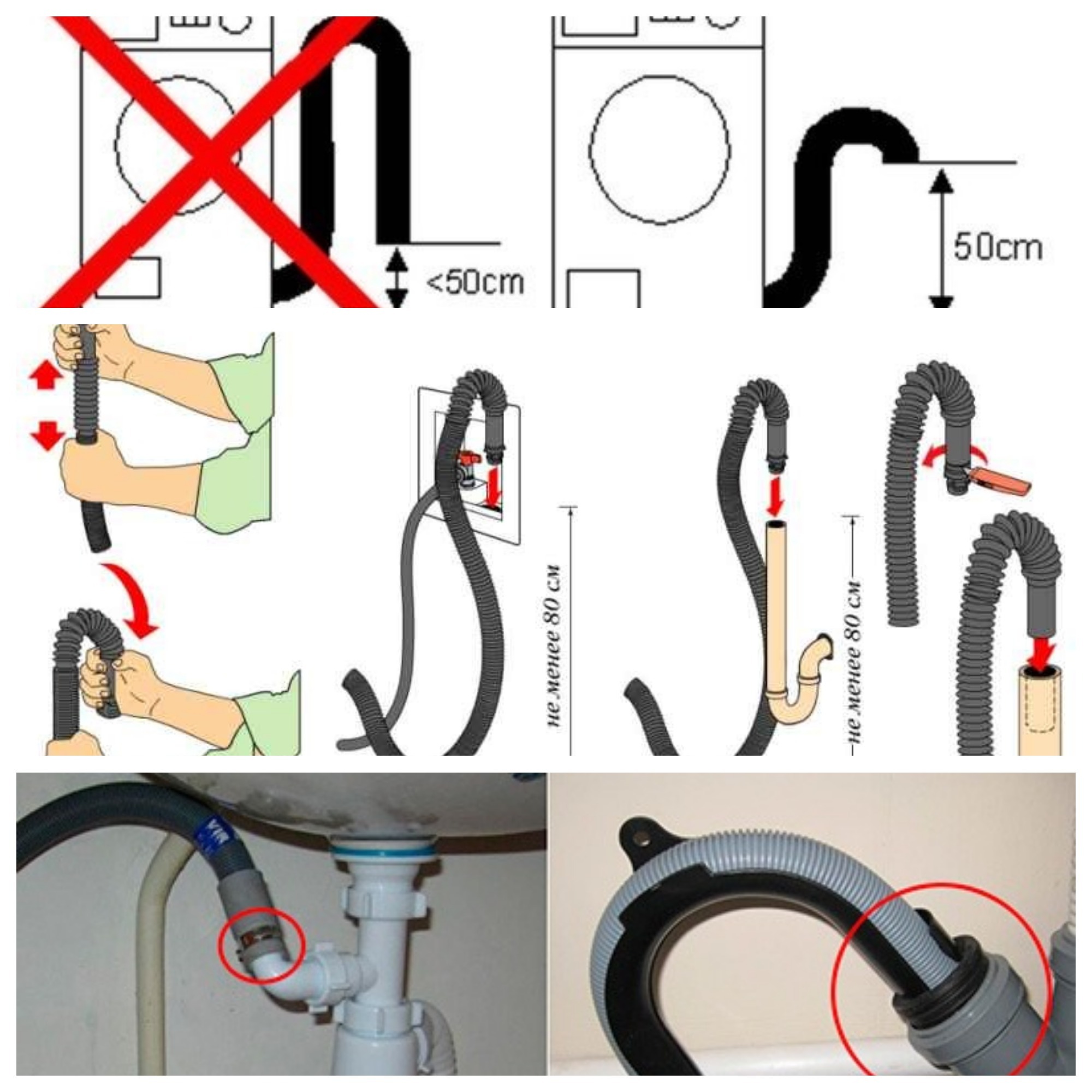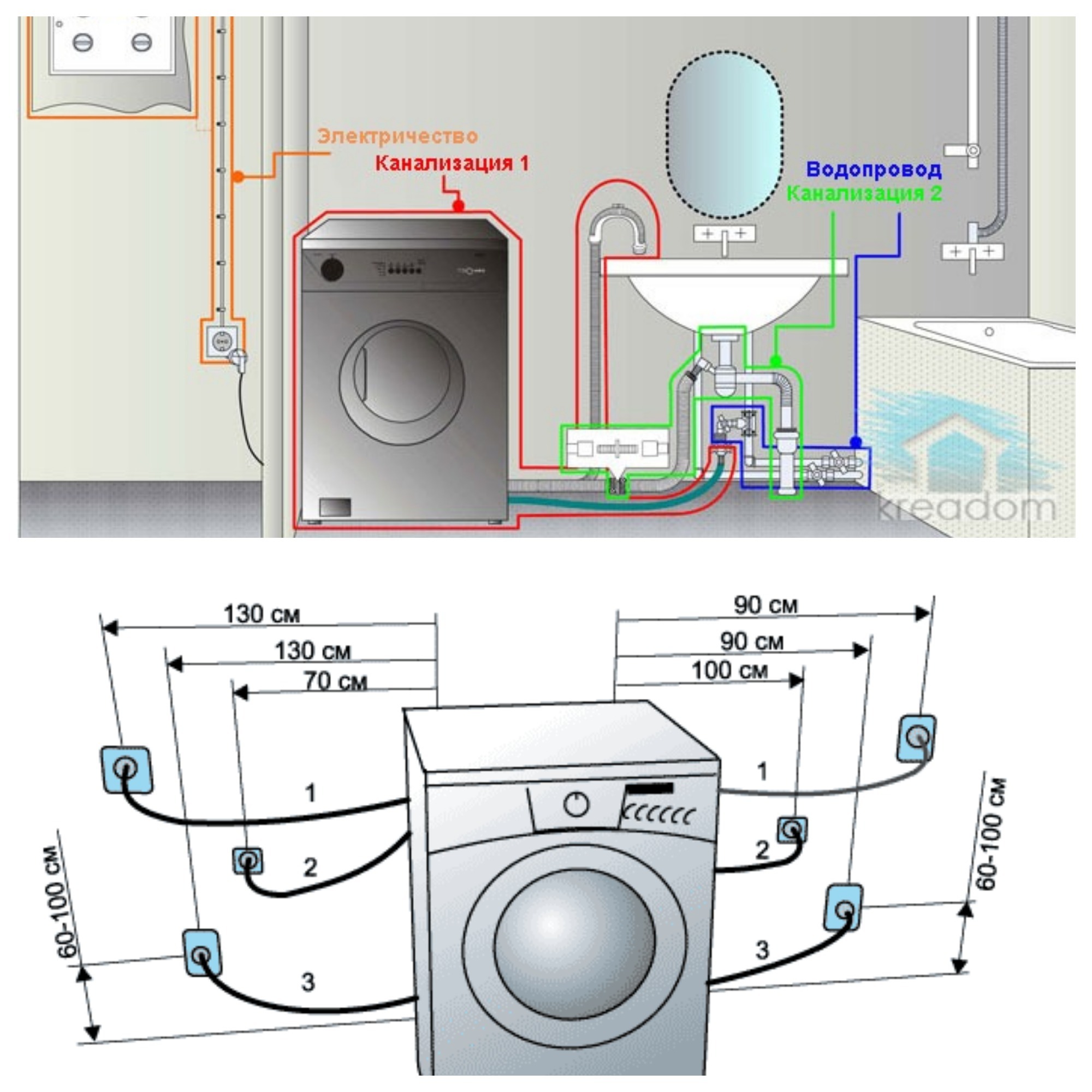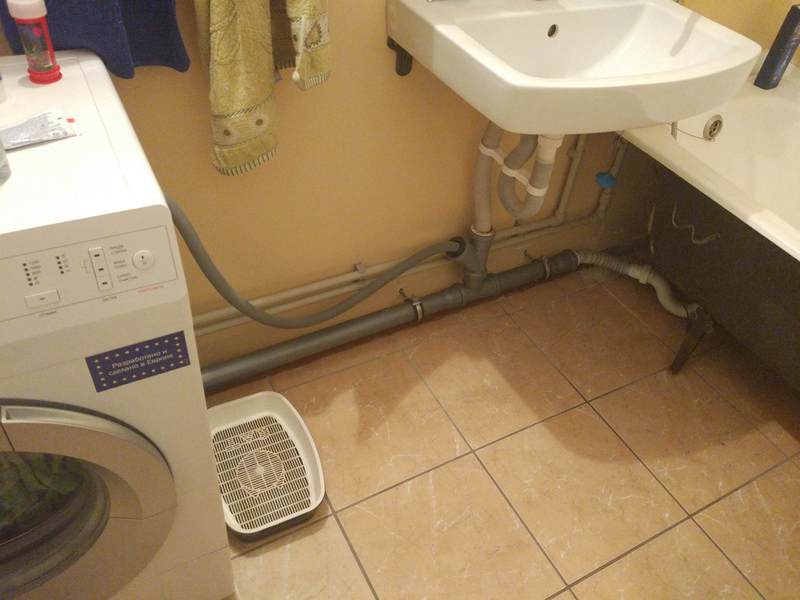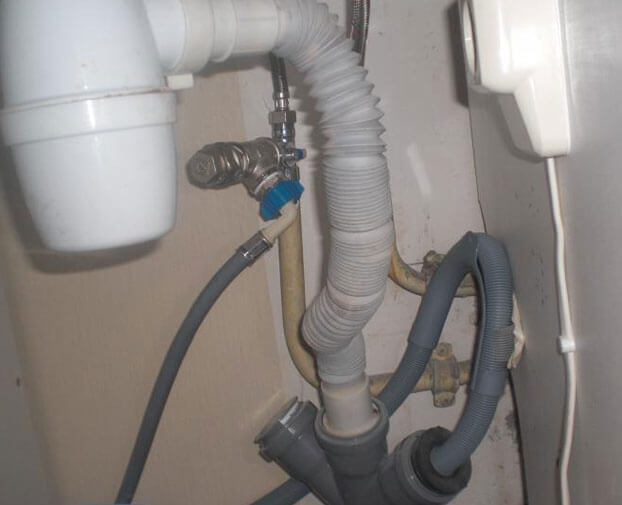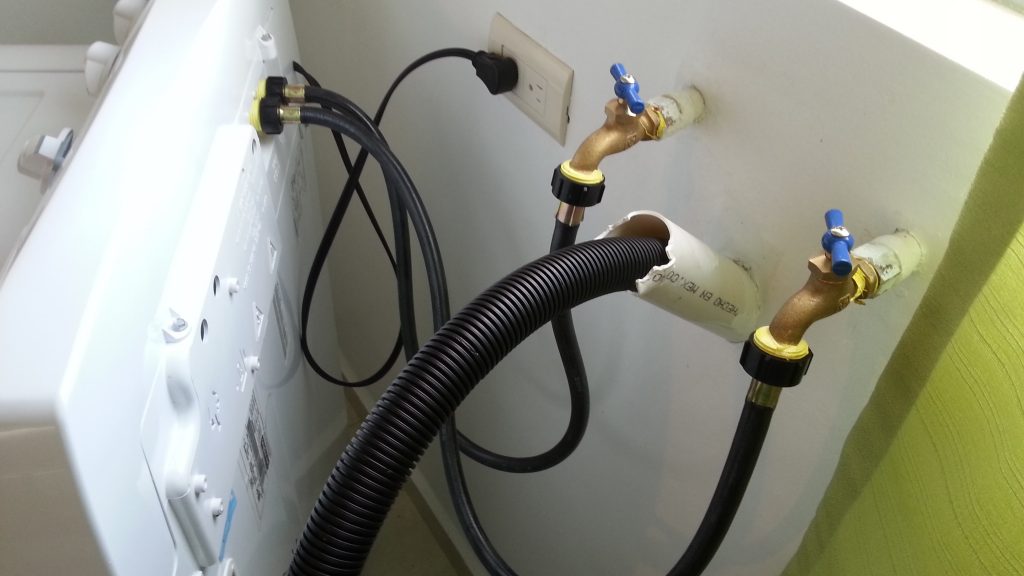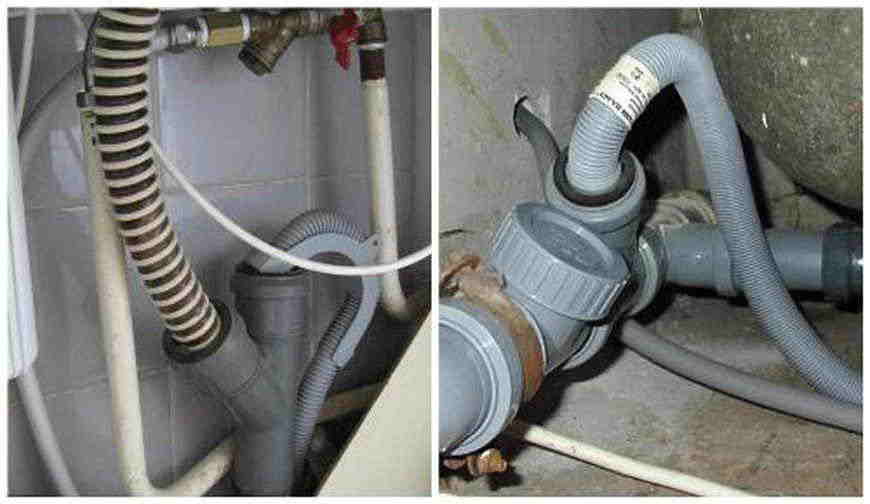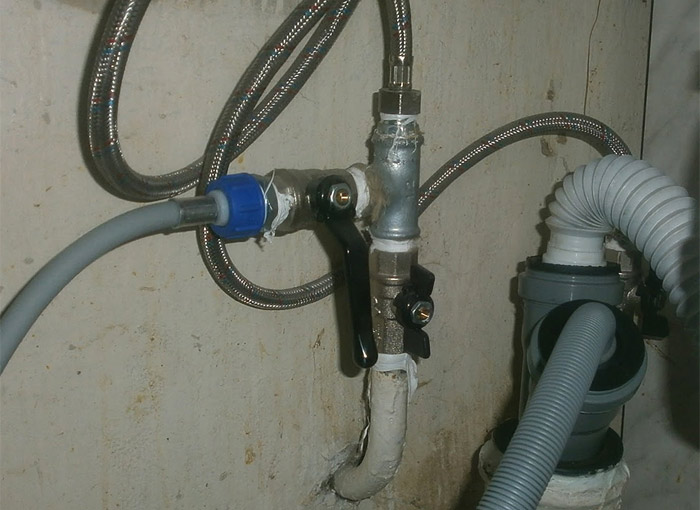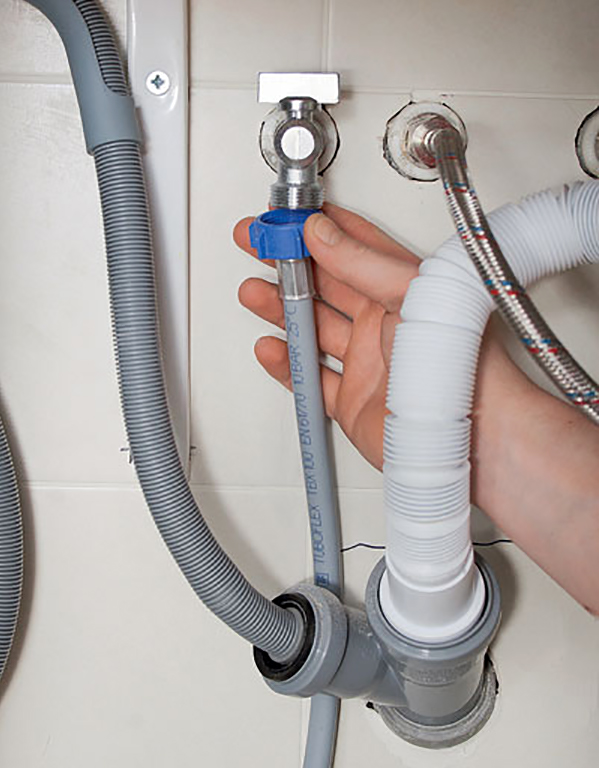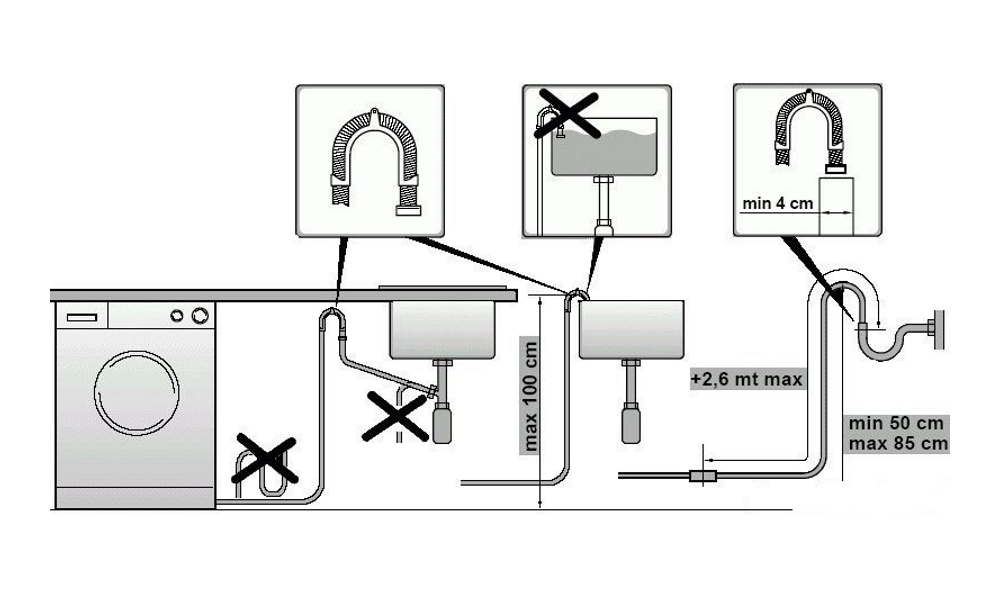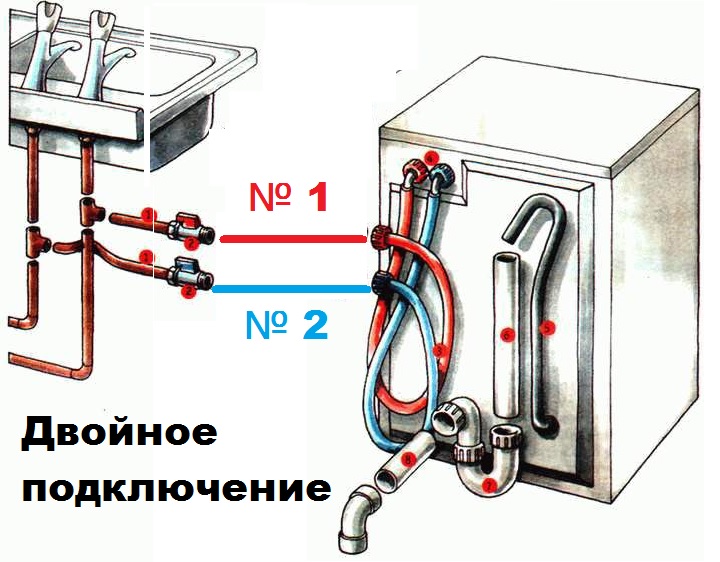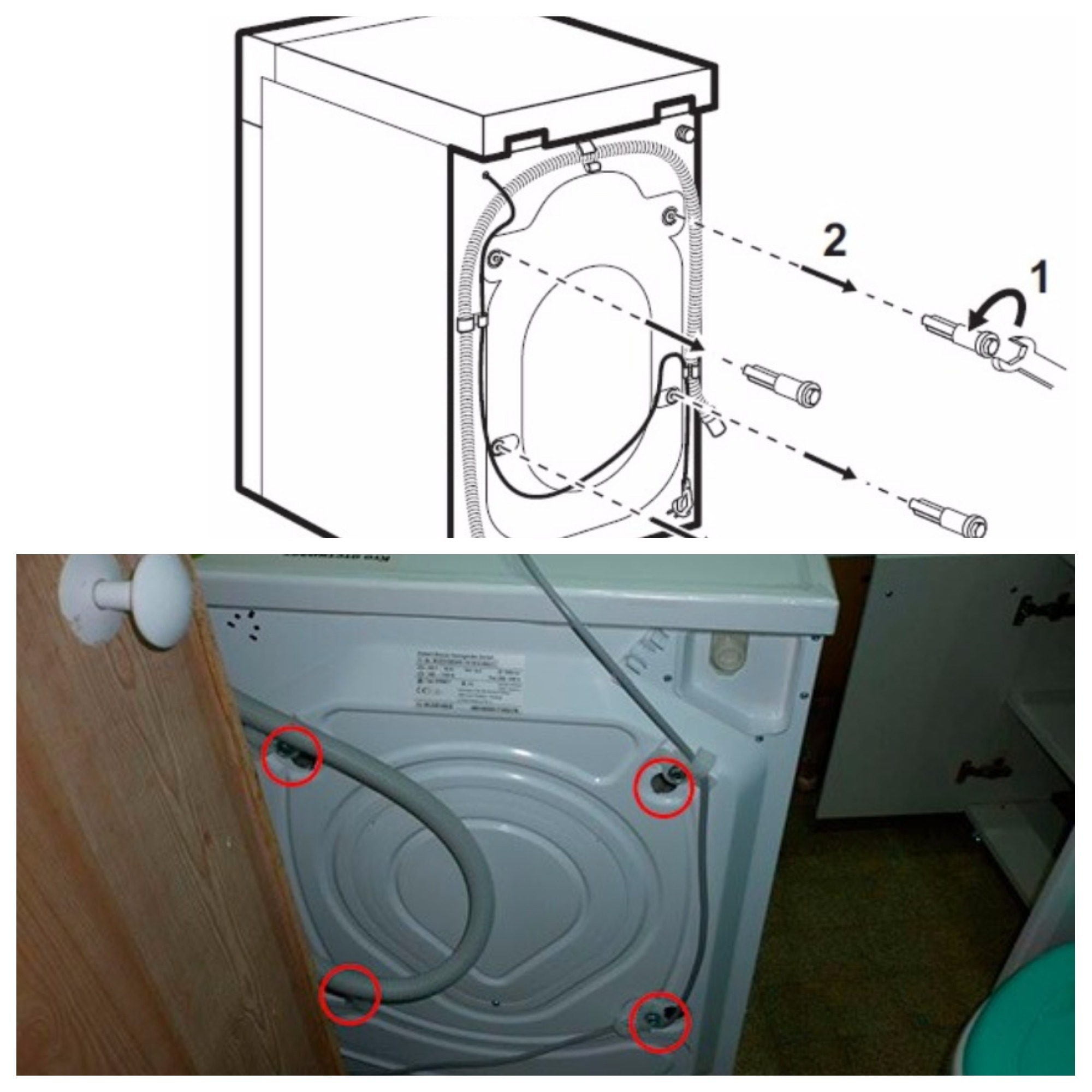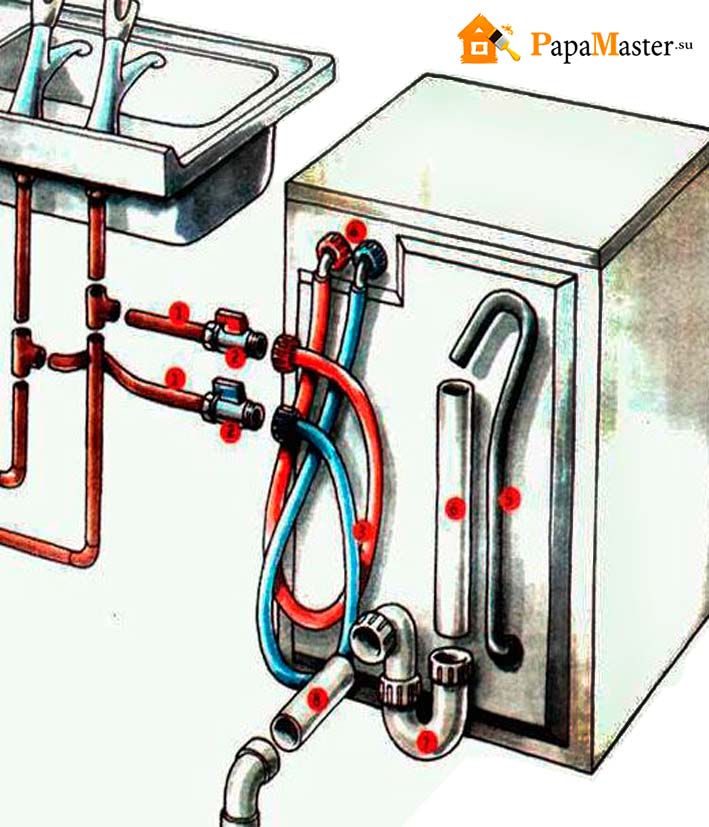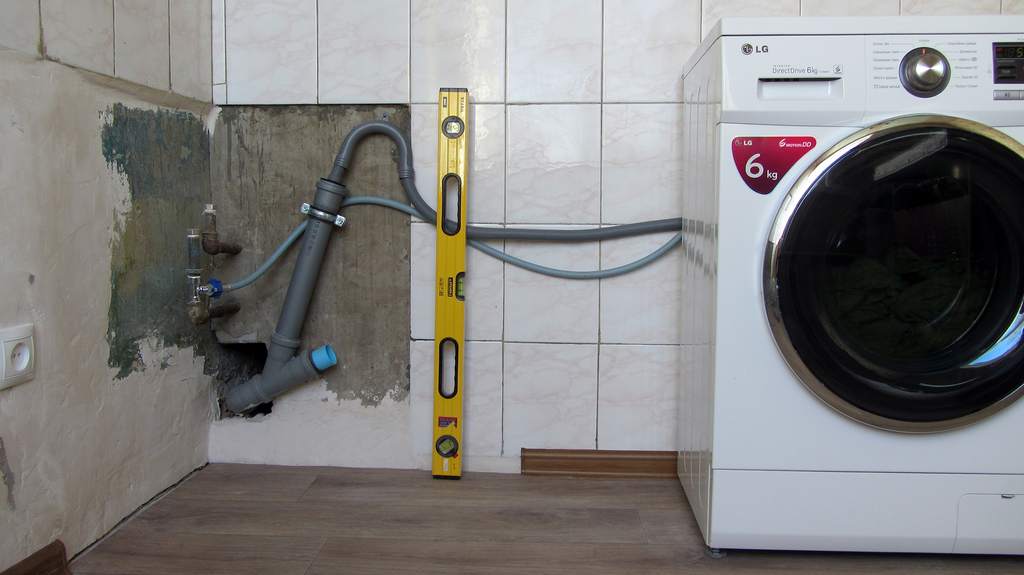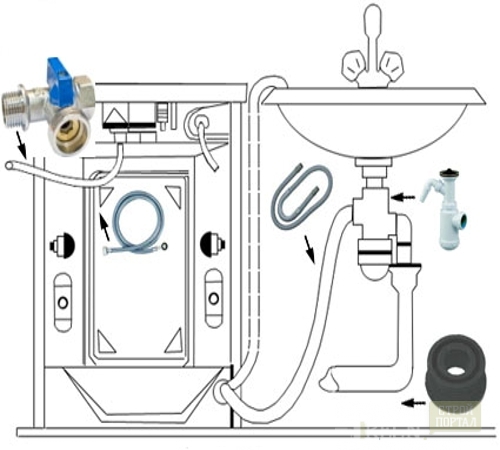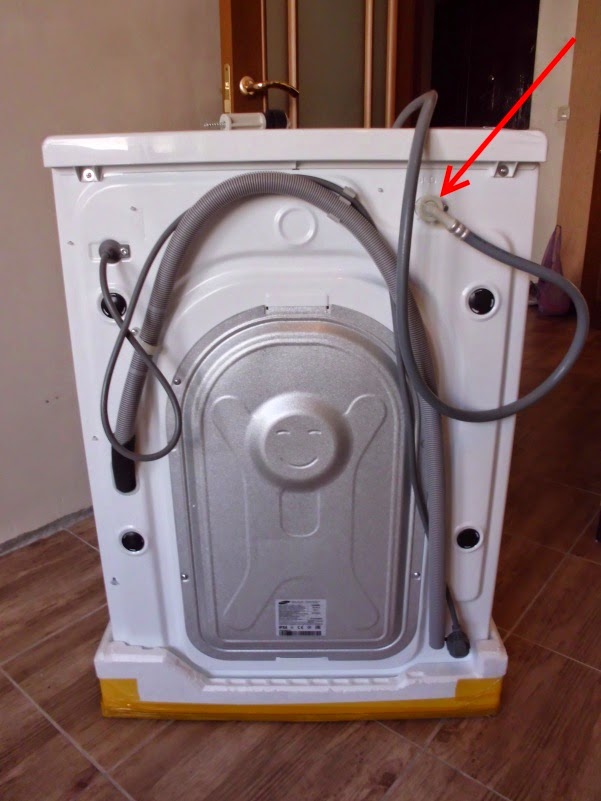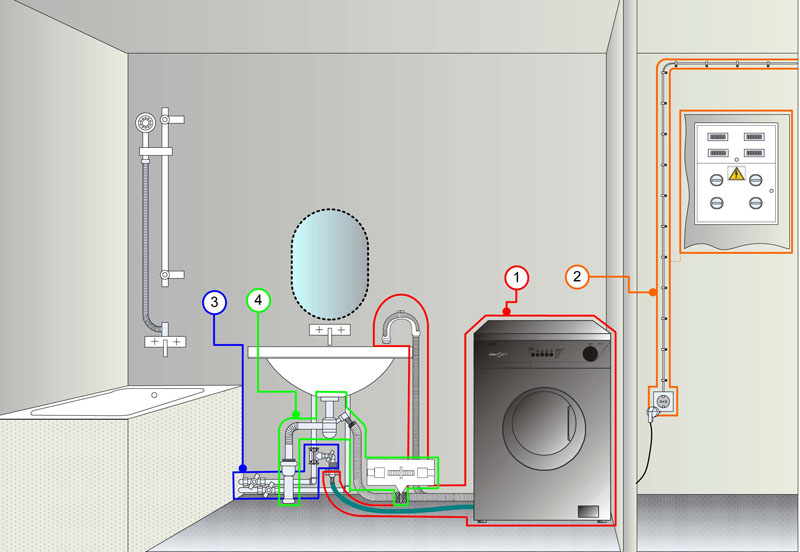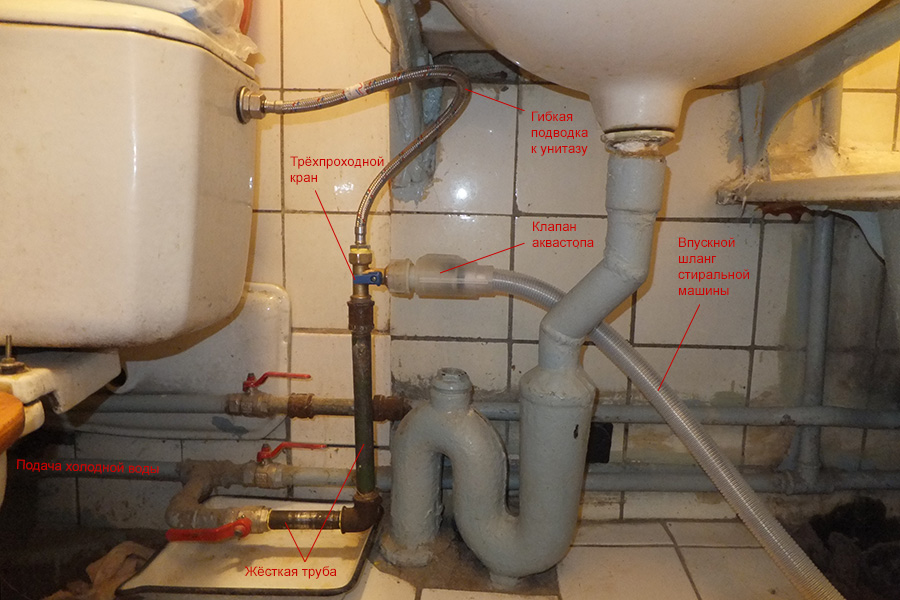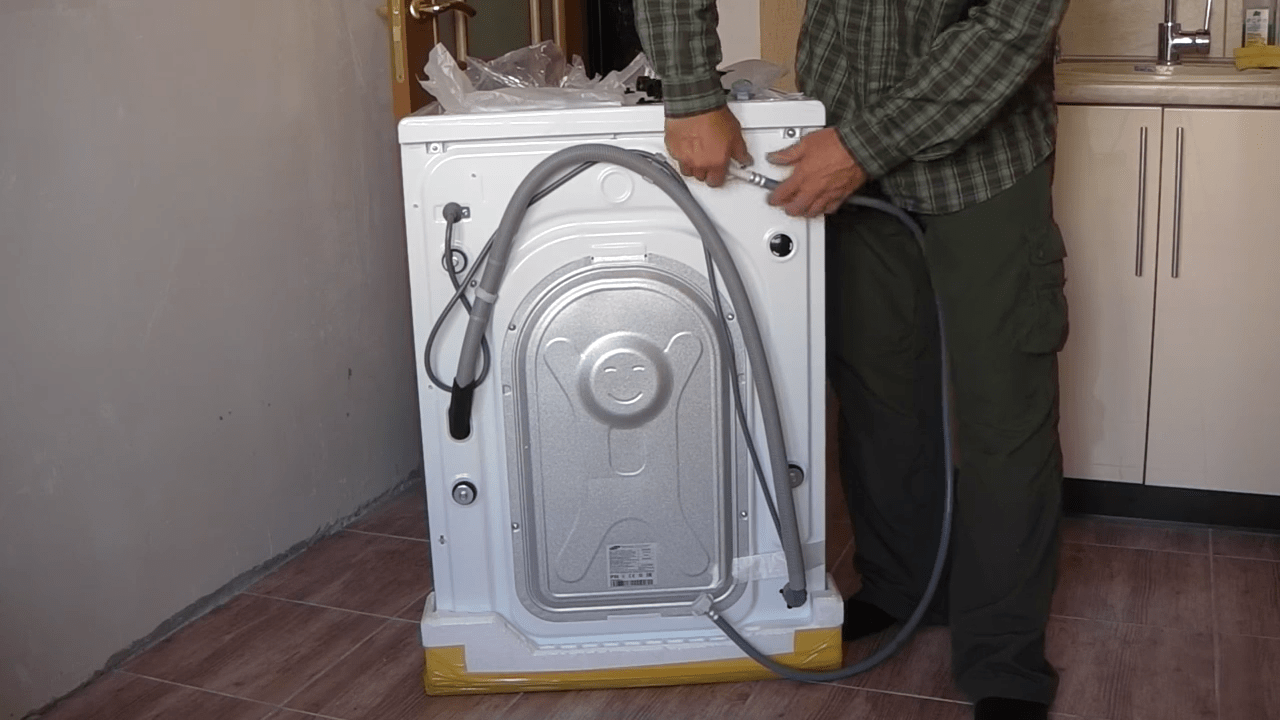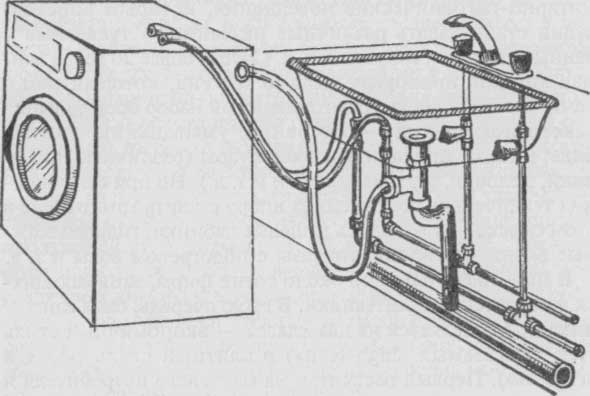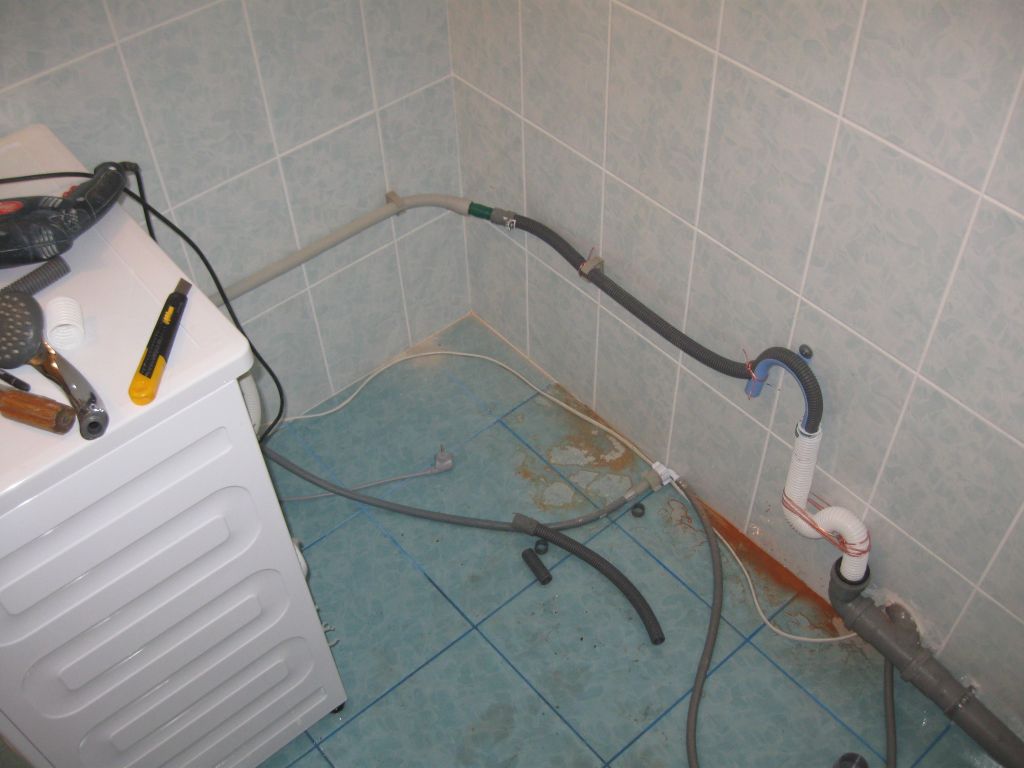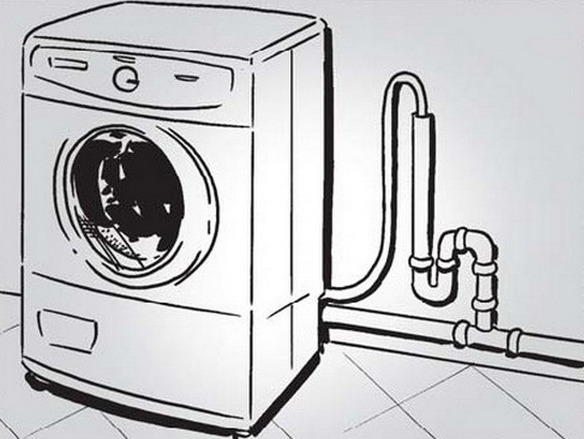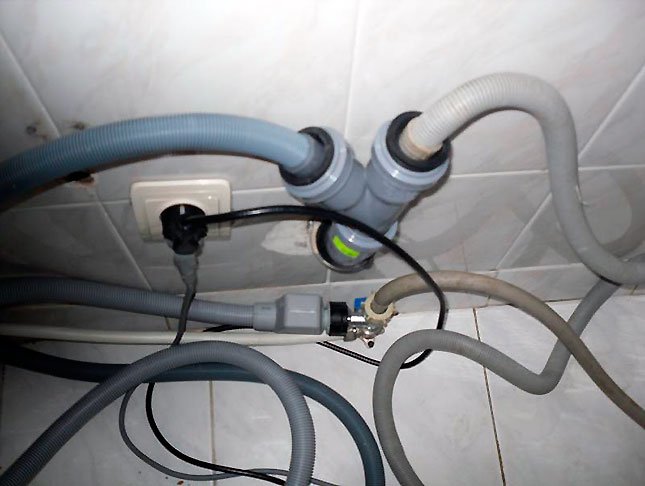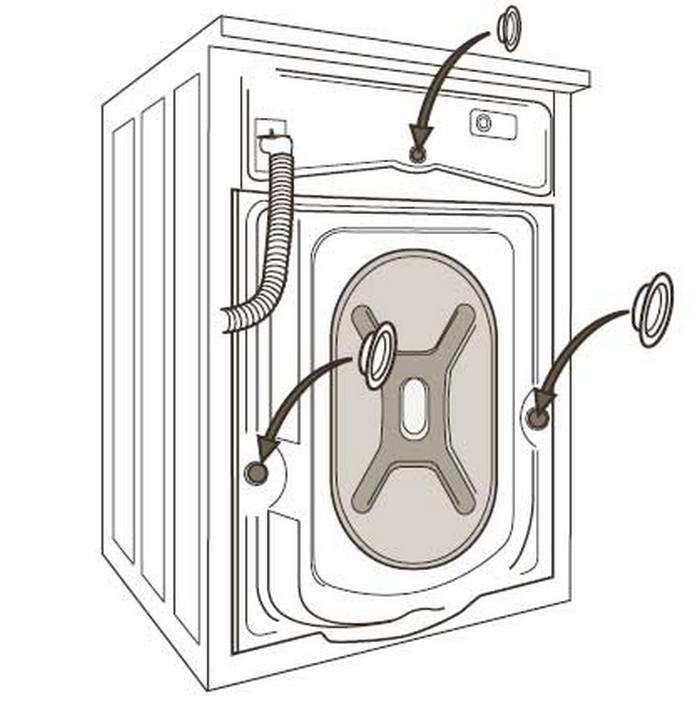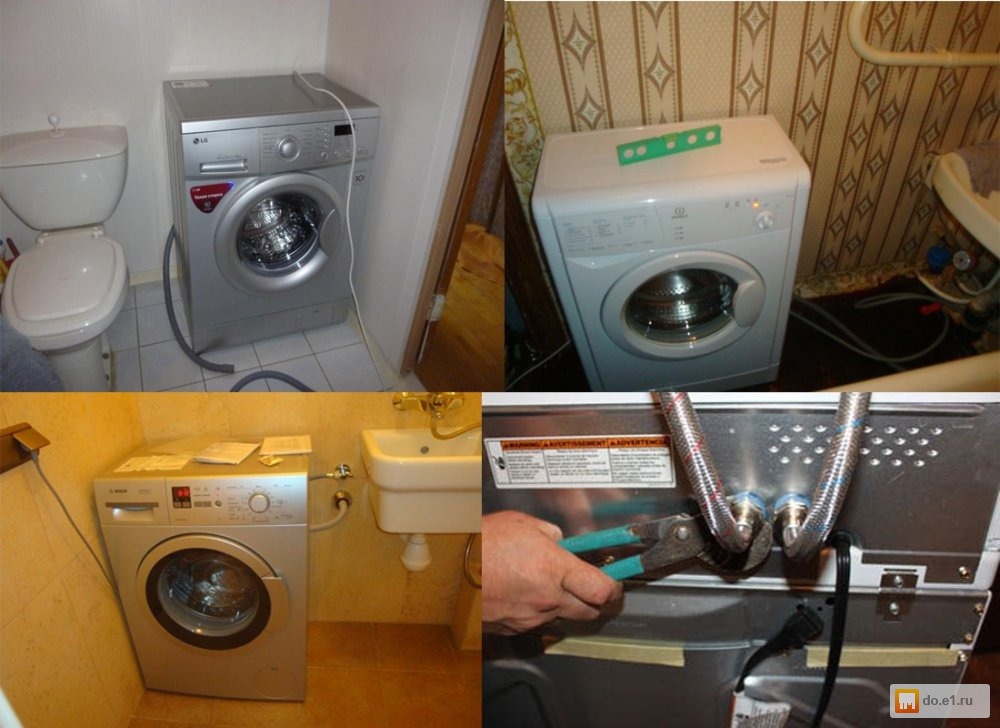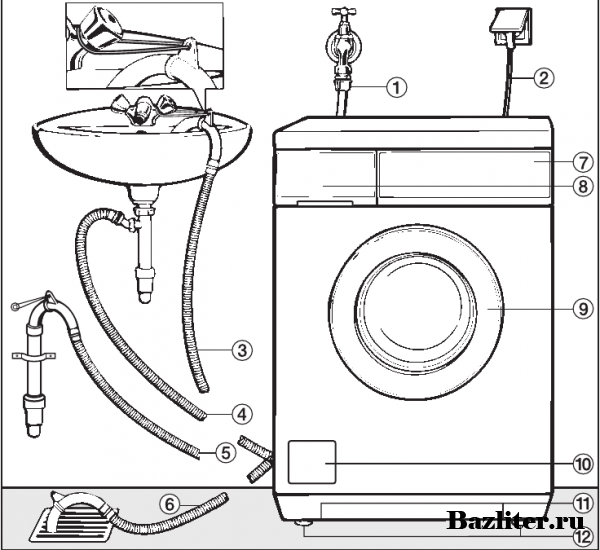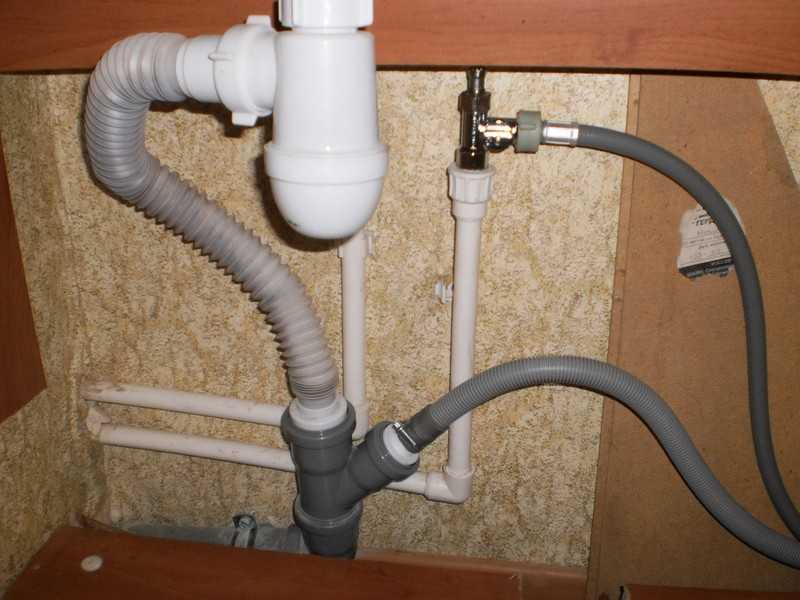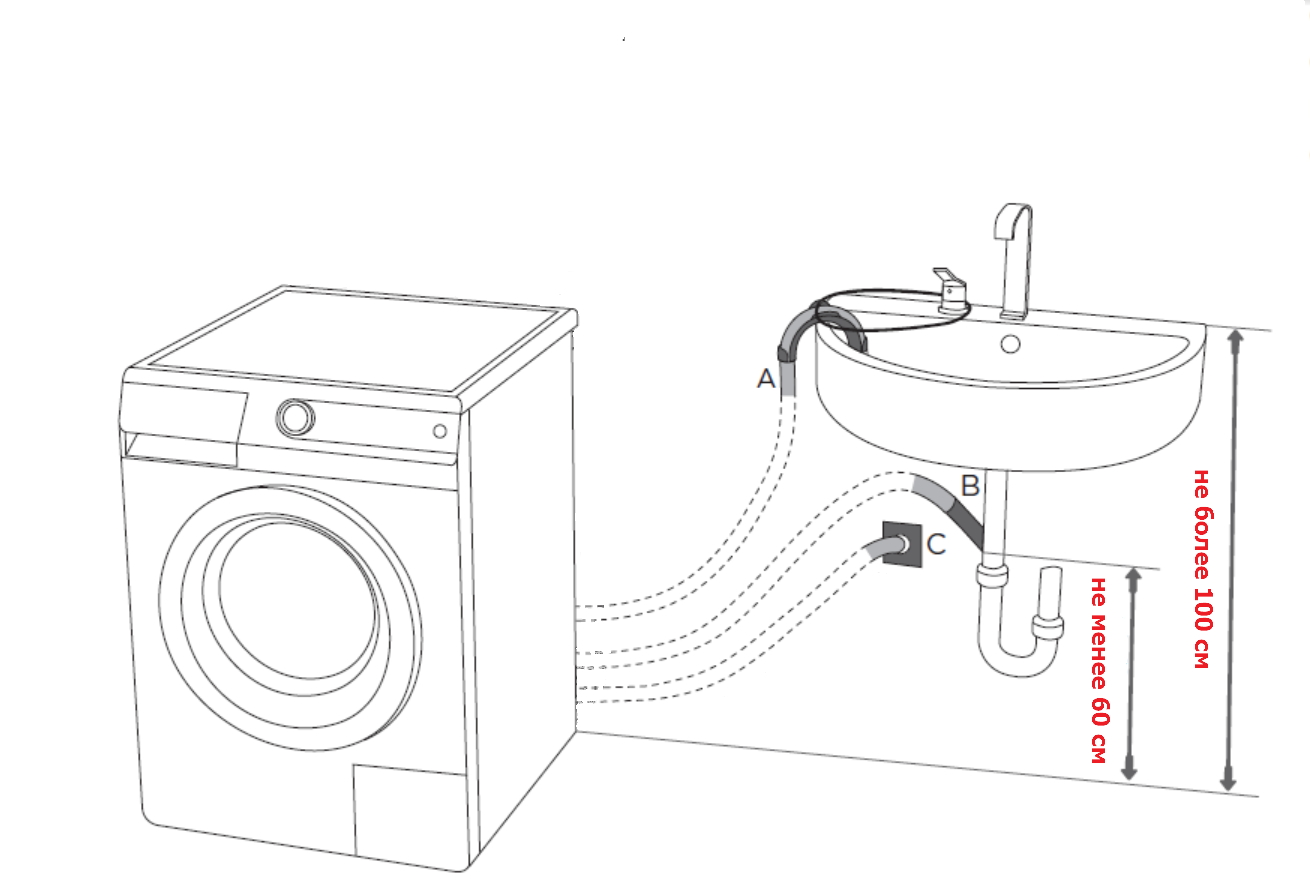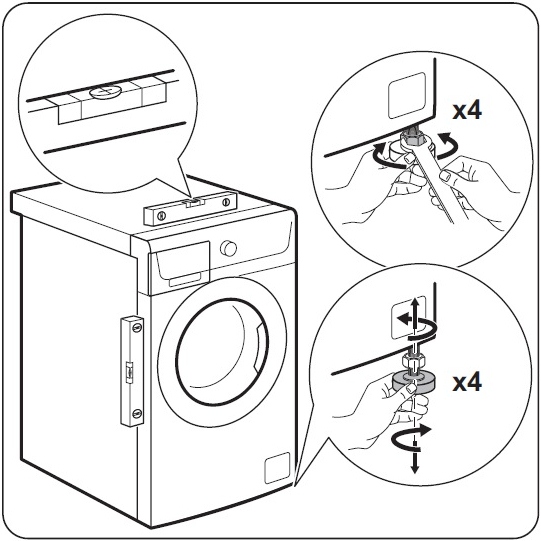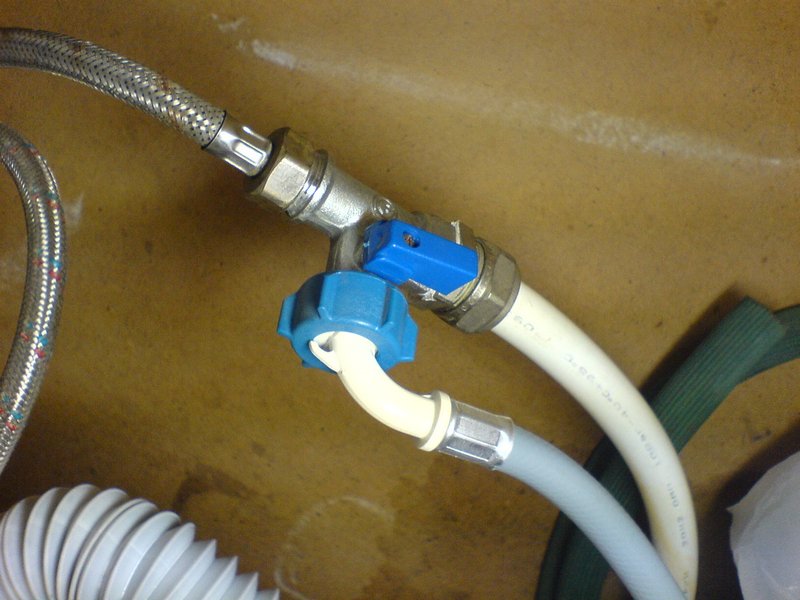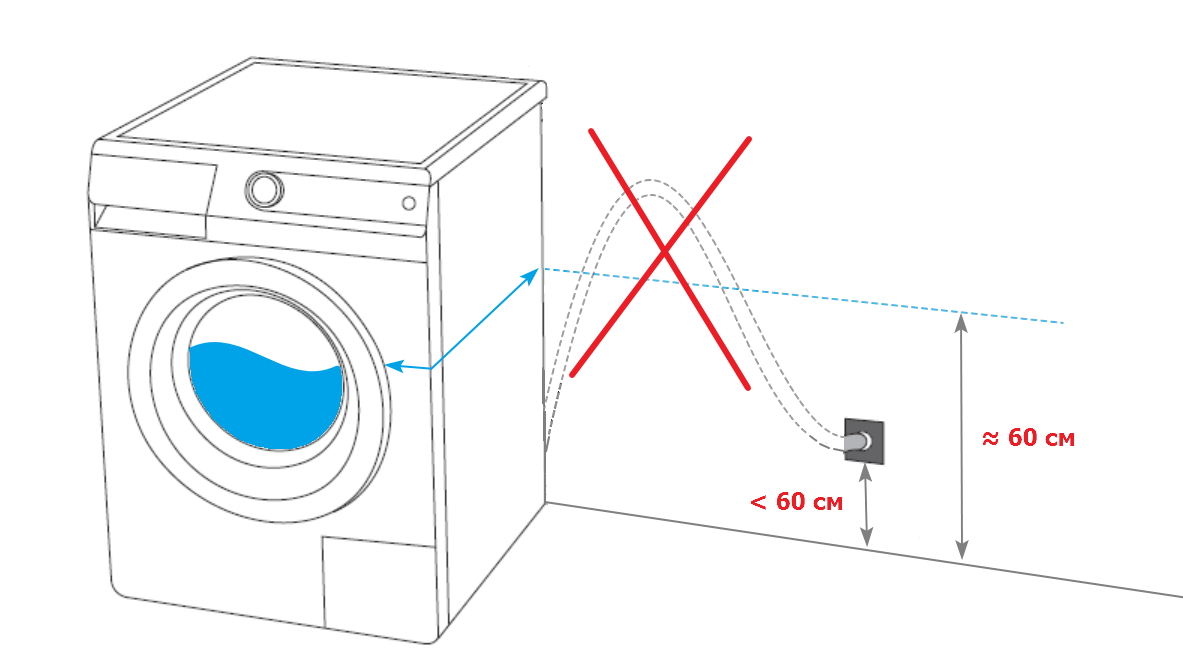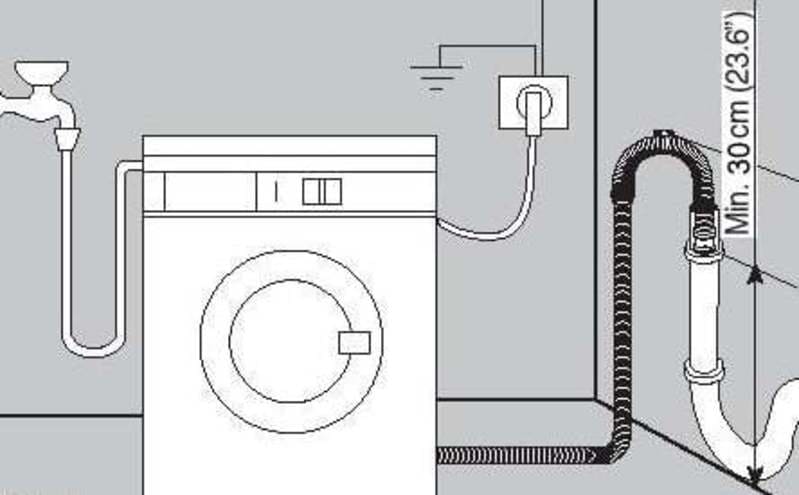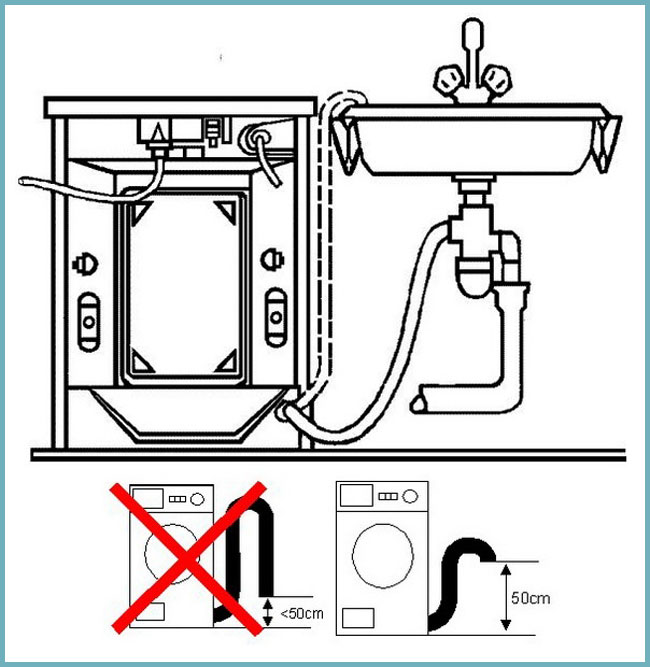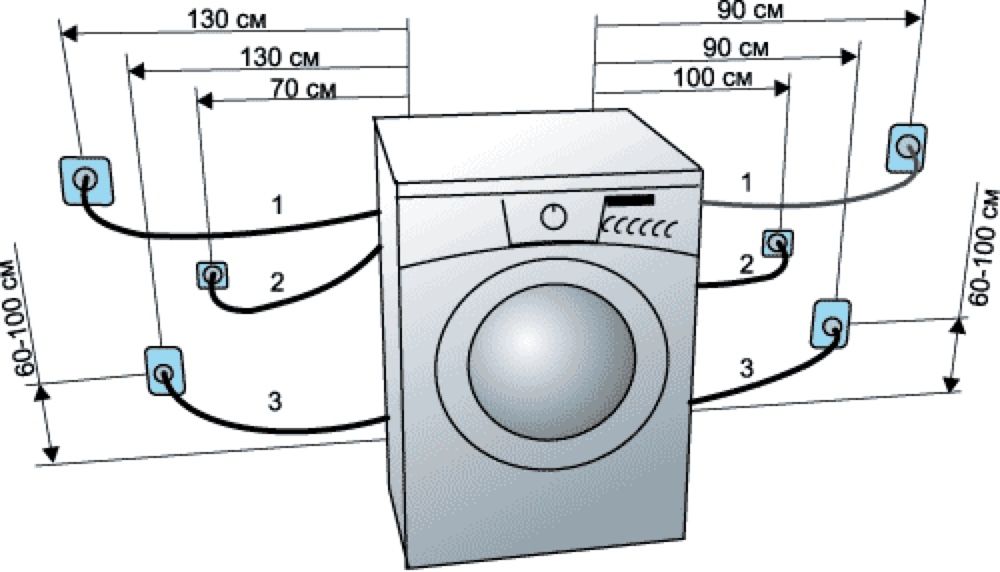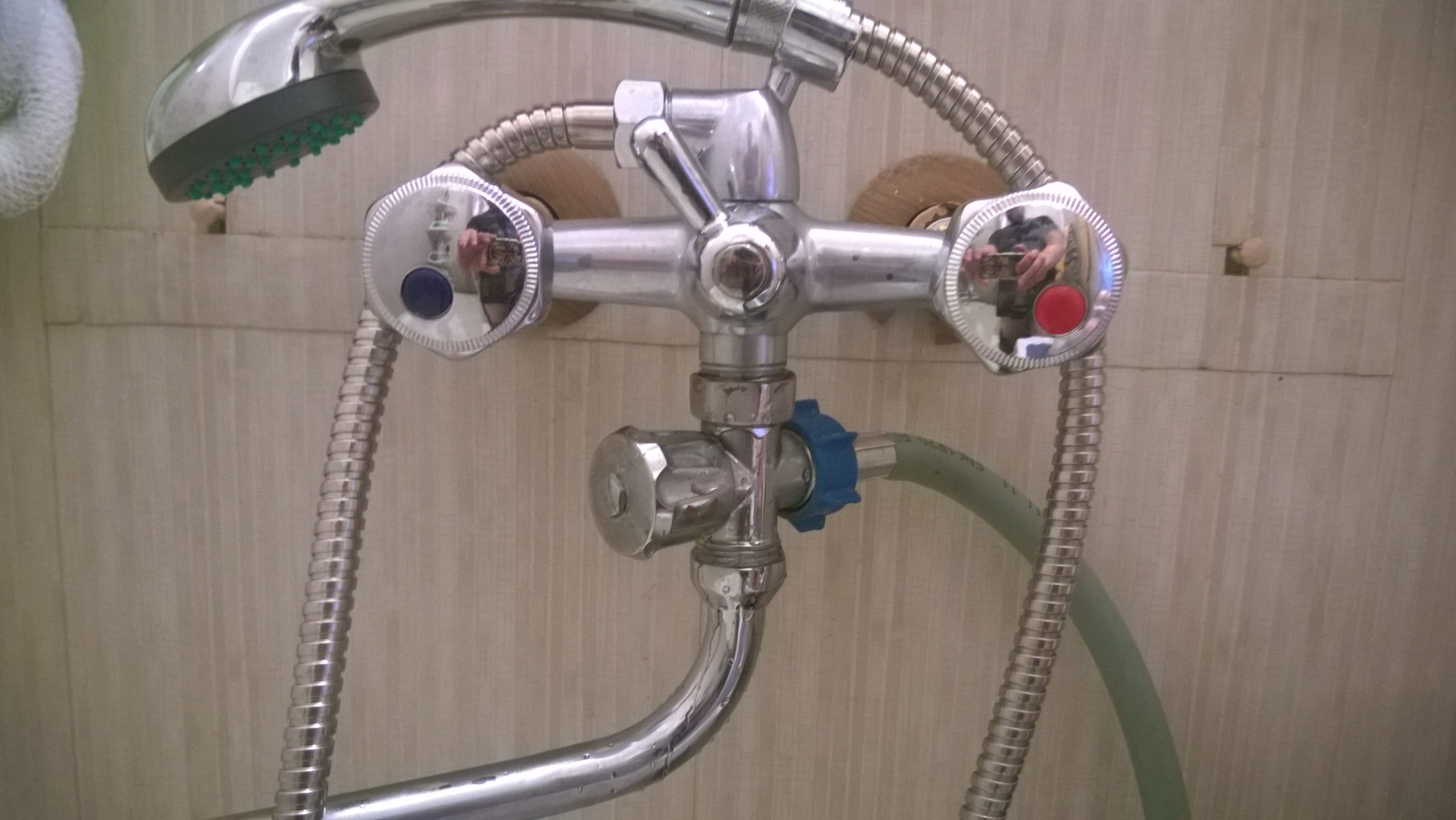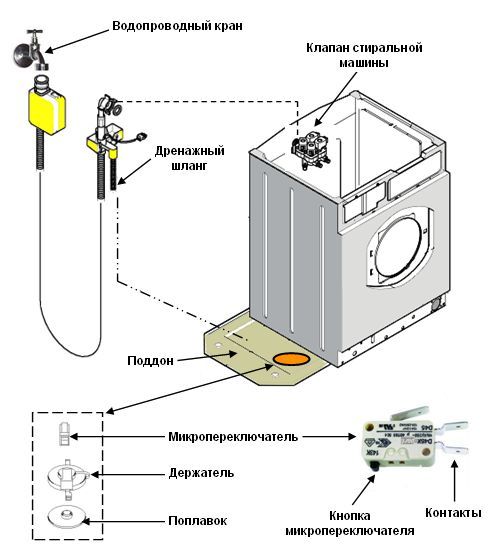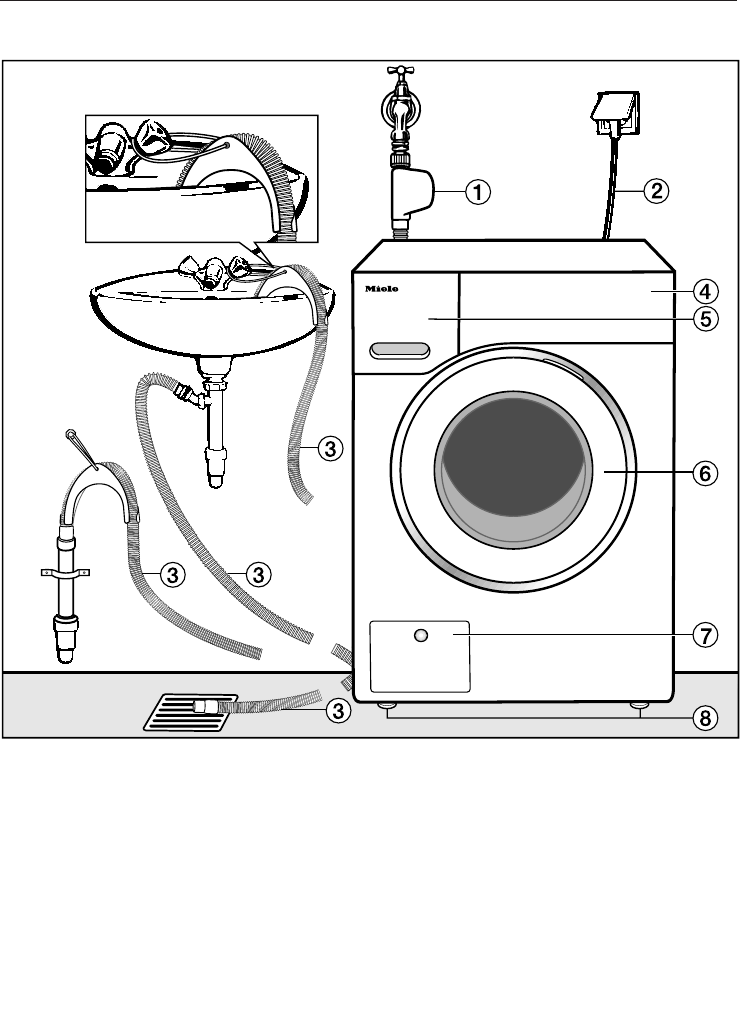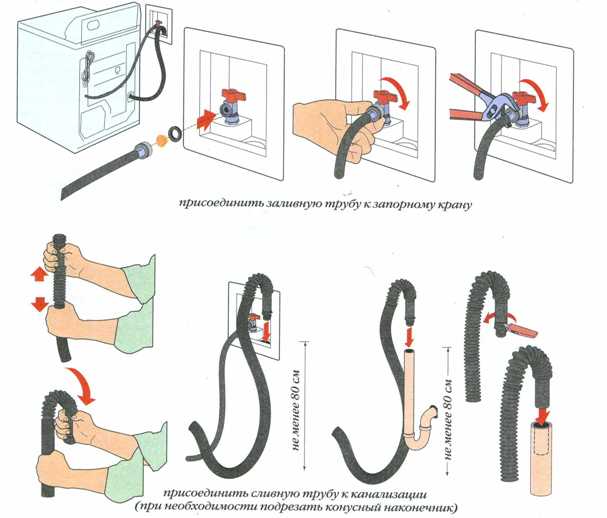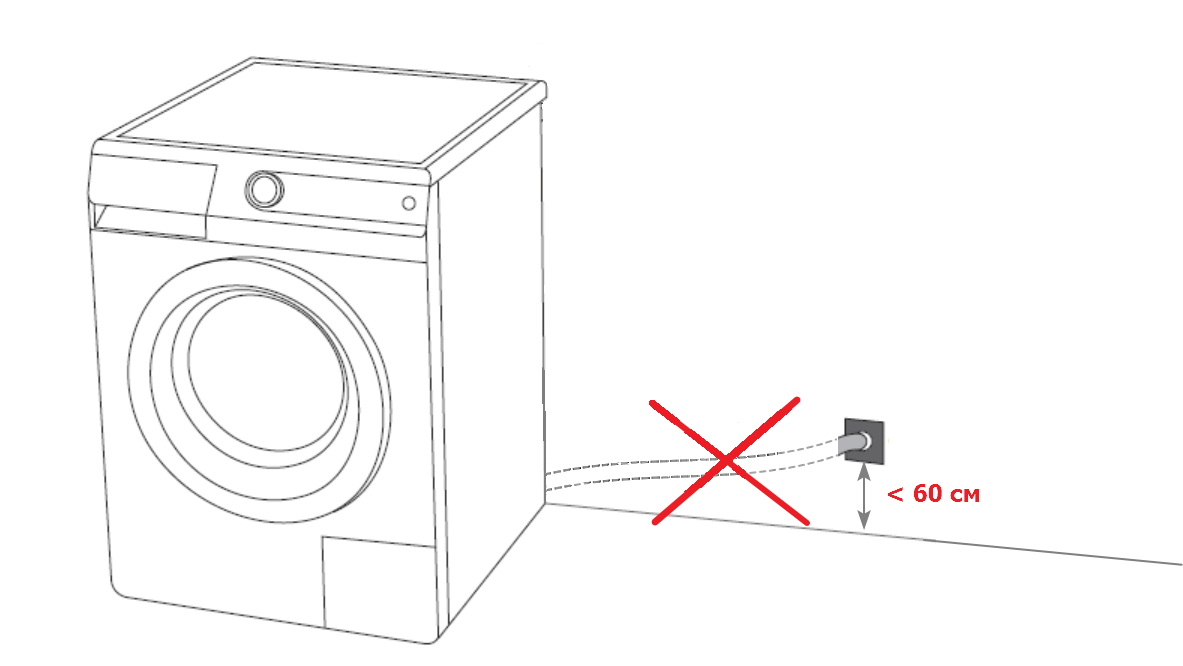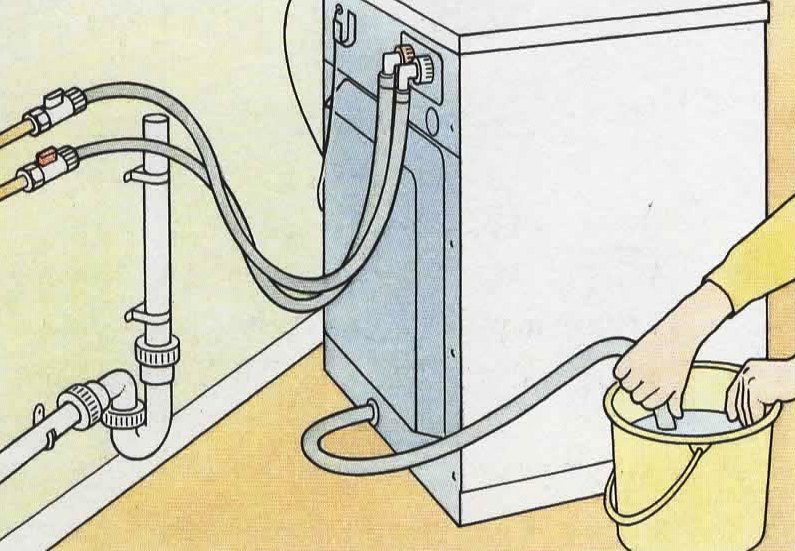To the sewer
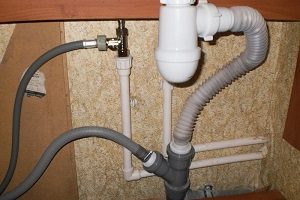
If the hose is not lifted in this way, the water will pour out immediately after entering the machine.
The free end of the hose can be lowered into the toilet, bathtub or sink. This is not the best option, because it is inconvenient and the end may come off. Then the water will flood the floor, and maybe it will get to the neighbors below.
There is a siphon under the sink. Remove the old siphon and install a special siphon with an additional hole for the hose.

- Make sure that the drain hose is not kinked. This makes it difficult for water to escape. Since the water is dirty, debris and dirt can accumulate at the bend.
- Do not pull on the hose. It should form a bend with a radius of 50 to 85 cm.
Accommodation options
There are several places where you can put your washing machine:
The most problematic option is the corridor. Usually, the corridor does not have the required communications - no sewage, no water. We'll have to "pull" them to the installation site, which is not easy at all. But sometimes that's the only option. In the photo below, there are several interesting solutions for how you can put a typewriter in the corridor.
In the photo - the option of installing a washing machine in a narrow corridor Do something similar to a portal - also a way out Hide in the nightstand Build in the furniture for the hallway
There are all communications in the toilet, but in typical high-rise buildings the size of this room is such that it is sometimes difficult to turn around there - there is absolutely no place at all. In this case, place washing machines over the toilet. To do this, make a shelf so that sitting on the toilet does not touch it with your head. It is clear that it must be very strong and reliable, and the machine must have very good shock absorbers. In addition, they must be positioned perfectly, otherwise they can "skip" during the spin cycle. In general, with this method of installing the washing machine, it will not hurt to make several slats that will prevent it from falling off the shelf.
The shelf is solid and reliable, but slippery - you need a rubber mat for shock absorption under the legs. Powerful corners are embedded in the wall, a washing machine is installed on them. Plastic stops were removed from the legs, and holes were drilled in the corners for the remaining screws
The fixation is reliable, it is only important that vibration does not tear the corners out of the wall. You can close it with vertical blinds. This is already a whole cabinet. Only the doors are missing
There is usually not very much space in the bathroom and the combined bathroom either, but still more than in the toilet. There is a choice here. If there is space, you can put a washing machine next to the sink. From above, you can install a tabletop, which will be a logical conclusion, and also solve the problem of water ingress on the case. To make everything look organic, you need to choose a machine of such a height so that it fits into the size, and the sink itself is better than a square one - then they will become wall to wall. If there is not enough space, you can push at least part of the body under the sink.
Put the washing machine next to the sink Fashionable bathroom countertops can be decorated with mosaics If space allows, just put the machine next to the sink
There is a more compact way - put the washing machine under the sink. Only the sink needs a special shape - so that the siphon is installed at the back.
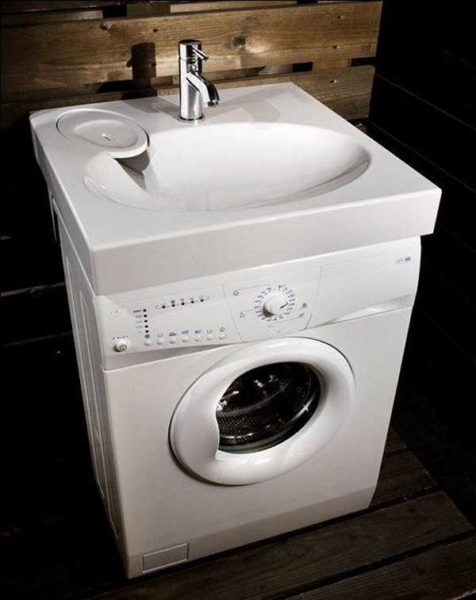
To put the washing machine under the sink, you need a special sink

One of the sinks under which you can put a washing machine
The next option for installing a washing machine in the bathroom is to the side of the bathtub, between its side and the wall. Today, the size of the cases can be narrow, so this option is a reality.
Narrow cases are no longer a rarity Between the bathroom and the toilet The sink should not be smaller than the cabinet Nobody bothers to install the sink from above
Just keep in mind that installing such equipment in bathrooms or a combined bathroom is not the best idea. Due to high humidity, the case begins to rust quickly (tested on our own experience). However, there is usually not very much space, although in principle, you can put the car under the sink or hang shelves over it. In general, it's up to you.
Another popular place to install a washing machine is in the kitchen. It is built into a kitchen set. Sometimes they close them with doors, sometimes they don't. This is at the discretion of the owners. Several interesting photos are in the gallery.
Doors with a cutout for the "porthole" Place in the kitchen cabinet The washing machine looks quite organic in the kitchen set
Stage 1. Choosing a place for installation
Washing unit location rules
The rules for the operation of washing machines require compliance with a number of mandatory conditions for their installation. The base on which the unit is located must be flat and solid, without horizontal distortions.
Otherwise, vibrations and beating of rapidly rotating assemblies and parts may occur, which leads to premature wear of expensive equipment. For the same reason, the machine should not be placed on soft carpet runners - it should be firm and as stable as possible.
There must be ventilation gaps around the machine body to prevent overheating of the machinery and the electric motor during operation. In the room, it is desirable to provide an optimal working atmosphere, without sudden changes in temperature and humidity.
Determining the installation room
The convenience of further use of the washing machine largely depends on the correct choice of the installation site. Most often, washers are installed in the following rooms:
Bathroom
 The most traditional location for washing machines. There are all communications necessary for connection - water supply, sewerage, electricity. The only problem may be the small area of the room. This is especially true for apartments with an old layout with combined bathrooms.
The most traditional location for washing machines. There are all communications necessary for connection - water supply, sewerage, electricity. The only problem may be the small area of the room. This is especially true for apartments with an old layout with combined bathrooms.
Kitchen
 Another popular option for the location of the automatic machine. There is also water supply, sewerage, electricity, so there are no special problems with the connection. The problems for placing the device in the kitchen of a standard apartment are the same as in the bathroom - the lack of free space.
Another popular option for the location of the automatic machine. There is also water supply, sewerage, electricity, so there are no special problems with the connection. The problems for placing the device in the kitchen of a standard apartment are the same as in the bathroom - the lack of free space.
The corridor
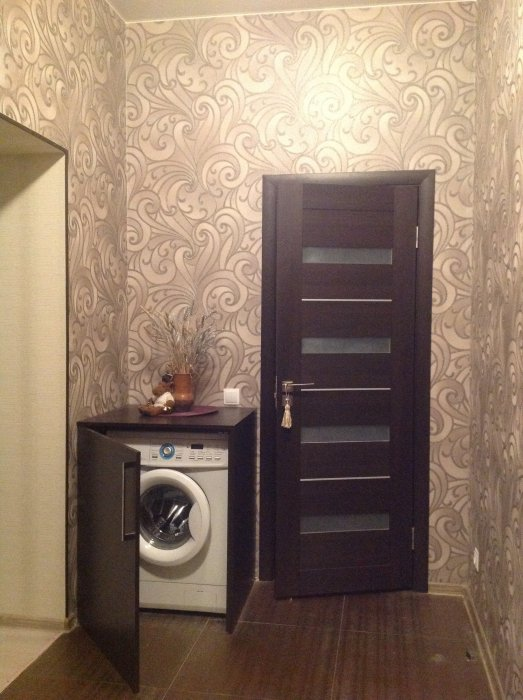 An option that is occasionally used if you did not work out the washing machine in the bathroom or kitchen for some reason. Installation of a washing machine in the corridor is possible if there are sewer and water pipes in it, into which you can bump.
An option that is occasionally used if you did not work out the washing machine in the bathroom or kitchen for some reason. Installation of a washing machine in the corridor is possible if there are sewer and water pipes in it, into which you can bump.
Connecting the washing machine to the water supply
Before connecting the washing machine to the water supply, it should be borne in mind that this procedure is very responsible and therefore it is necessary to take it quite seriously. To make such connections, a water supply hose with appropriate fittings is usually supplied with the washing machine, but quite often its length is not enough to connect the washing machine in the required place. In view of this, the following water supply methods are quite often used:
- Using a longer rubber hose (can be purchased at specialized points);
- Implementation of a fixed connection.
In the first version, the task of the contractor is only to connect the finished product to the inlet of the washing machine and the water intake point. It is advisable to carry out these procedures on the basis of certain recommendations.
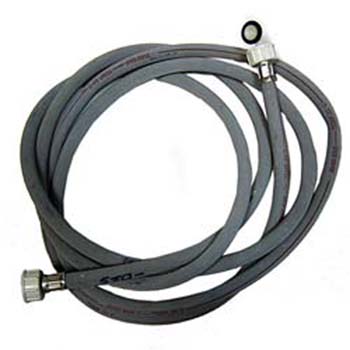
Firstly, the water supply hose should be laid in a place that is least susceptible to mechanical damage (it can be brought under the bathroom or hidden by furniture elements). Secondly, you should not connect the hose to a stretch, since during the operation of the washing machine its deformation may occur, caused by the vibration of the appliance.
And, thirdly, one should not forget about the quality of the purchased accessory. After all, used in aggressive conditions, such a pipeline must provide a reliable and tight connection.
In the second case, the water supply can be realized by laying stationary communications.For these purposes, both metal pipes (copper) and plastic-based systems can be used. It is impractical to connect the washing machine to the water supply system using ordinary steel pipes, as this can cause clogging of the main units of the machine with suspended rust particles that can form in the cavity of such pipelines.
As in the first case, the system must ensure high tightness and prevent leaks. It should be noted that it is still not worthwhile to directly connect stationary pipelines (especially metal ones) to the inlet of the washing machine (due to the occurrence of vibration). The best option would be to use a flexible hose adapter.
In both the first and second versions, when connecting the washing machine to the water supply line, it is advisable to ensure that the following conditions are met:
- Make connections using shut-off valves (ball valve), which allows you to turn off the consumer if necessary;
- Before entering the washing machine, install special mechanical or magnetic filter systems that allow supplying water purified from pollutants to the unit;
- As points for water supply, use either ready-made taps (to the mixer or flush cistern), connecting pipelines through tees, or pre-mount individual points for liquid intake (nozzles, squeegees).
We carry out the correct unpacking
Complex household equipment, such as a washing machine, is carefully packed by manufacturers to prevent damage to products during transportation. Therefore, before starting the installation work, the device is freed from the factory packaging, and then the bolts with which the tank is specially fixed are unscrewed. The manufacturer supplies plugs with the device, which are used to close the holes formed. Bolts removed from the machine must be stored and used as intended when the equipment is being transported.

Removing shipping bolts and installing plugs
The procedure for removing the shipping parts is indicated in all details in the text of the instructions that must be attached to each household appliance by the manufacturer. When buying imported equipment, make sure that the instructions are translated into Russian. If you carefully follow the diagram in the buyer's manual, you will be able to connect the washing machine without any problems.
Water connection
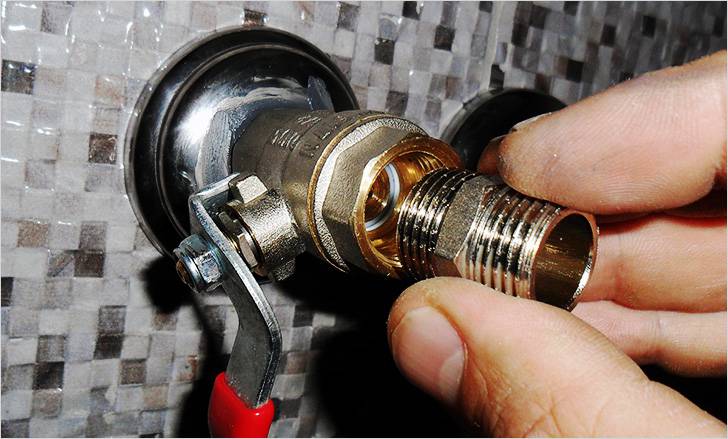 Water connection
Water connection
If you follow the detailed instructions, connecting the automatic machine will not be difficult.
The washing machines are supplied with rubber hoses. They are usually of a standard length, and very often they may not be enough for a convenient installation of the clipper. Therefore, alternatives are often used, such as:
- Purchase a longer hose.
- Stationary water supply equipment.
For the first case, you just need to connect the hose to the water source
It is important to take into account that the hose must be laid in a place that is not subject to any mechanical damage. It can be covered with furniture
Also, you do not need to install the hose in a taut state, otherwise it can be damaged by vibration during washing. It is important not to save on this accessory, since the duration of the machine's operation and the tightness of the connection to the water intake point depend on it.
If you use the second connection option, then you can lay a stationary water supply using copper or plastic pipes. Professionals do not recommend carrying out steel pipes, since in this case, rust can accumulate in the elements of the machine, collecting in the ferrous metal pipeline. In such a system, leaks cannot be allowed, therefore, complete tightness must be ensured.
For both cases, the same conditions apply:
- When connecting to the water supply, you need to install ball valves, since they allow you to shut off the water in a separate section of the system.
- It is advisable to install cleaning filters at the inlet of the machine so that purified water gets into it. This will contribute to greater durability of the device.
It is important to connect the machine either to ready-made taps, such as a mixer or a cistern, using tees, or before installation, specially mount the water taps through the pipe
How do I prepare to install my washing machine?
You have purchased a washing machine, delivered it to your home, now your task is to prepare it for installation. Initially, you need to decide on the place where the electrical device will be installed, a reliable assistant in the future. In fact, the machine can be installed completely anywhere, but it is best to install it in the bathroom, in the kitchen, in the pantry, or in the hallway. Be that as it may, your guests may be very surprised if the washing machine is in the living room or bedrooms.
Choosing the right place to install the washer
Be sure to consider all the main features when choosing a place for a washing machine:
- water supply, sewerage and electricity - without fail must be laid close to the car;
- the machine looks aesthetically pleasing in a new place, its height and width fit perfectly into the overall picture;
- flat floor surface;
- the optimal solution for its operation.
Checking and preparing all parts for installation
Pay attention to the transport details before installation. They should be dismantled without fail, because otherwise you may be left without a washing machine altogether, because it will simply break down.
Most often, wooden beams are used to transport the washing machine, as well as bolts.
These manipulations with the machine should be carried out after you have read the basic rules of the instructions, since you need to read them very carefully so as not to harm the device.
To install the washing machine properly, you need to pay attention to the quality of the floor covering exactly in the place where you will install the washing machine. Be sure to fulfill the following requirements:
Be sure to fulfill the following requirements:
- create a solid base structure;
- prepare a horizontal surface;
- the base material must be stable;
If all the criteria do not agree with you, you definitely need to take action. Since the floor must be in perfect order before installation, if there are any deviations, be sure to carry out repair work.
Conditions for installing the device
Before you start installing a new washing machine, you will have to study the requirements and conditions for its installation. This will help you connect the device correctly.
The optimal place: we take into account the dimensions and model of the machine
Many are interested in whether it is possible to install a washing machine in the corridor. Experts do not advise doing this, since the corridor is considered not the best place for a washing machine. Better to install it in the kitchen or bathroom. At the same time, when choosing a suitable place, the following features are taken into account:
- Distance to the sewer drain. In the kitchen or bathroom, the device is installed in such a way that it is at a distance of 90-120 centimeters from the sewer.
- Room area. The washing machine should not be installed in a room that is too small, as it takes up a lot of space. Therefore, some people refuse to put them in small bathrooms.
- Space for opening the hatch. If a front or vertical loading model is used, the clearance in front of the hatch should be 75-85 centimeters.
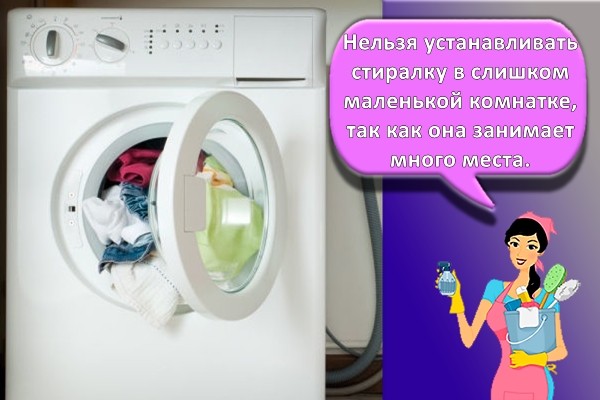
Floor quality
It is recommended to install the device on a floor that can handle the load without any problems. Therefore, experts recommend placing washing machines on rough concrete flooring. You should not put a washing machine on the tile, as it will move due to vibrations that appear during washing.
Wiring requirements
It's no secret that you need to connect any machine to electricity. In order for the electricity supply to the washing machine to be of high quality, it is connected to a wiring made of three-core copper cables. The device should not be connected to aluminum wiring, as it will not cope with the load.
Helpful advice from experts
There are many options for how to connect the washing machine to the water supply, sewerage system and the mains. Some of them are not correct and can shorten the service life of the equipment and negatively affect your health. To prevent this from happening, we provide readers of "Sam Electrica" with several important tips:
- Do not under any circumstances connect the grounding contact to radiators or gas and water supply lines.
- Instead of fumlent, you can also use flax and paste, which are equally effective at blocking drips.
- Few people know, but an automatic washing machine can be connected not only to the central water supply, but also to an ordinary barrel of water. All that is needed is to position the tank at least 4 meters above the equipment itself. A distance of 1 meter will give a pressure of 0.1 atmosphere, while 0.4 atmosphere will be enough for the machine to function even without a pump. This idea is often used in a village at a dacha, where the water supply is unstable or there is no running water at all (a well or a well).
- Expose the building to the building level. The slightest misalignment will cause vibration.
- Do not place pieces of rubber or linoleum under your feet. It is only necessary to adjust the height by unscrewing / twisting them. The substrates will also negatively affect the vibration of the equipment during the operation of the centrifuge. Even if the floor is uneven to prevent the washing machine from jumping, adjust the feet correctly.
- Do not discard the transit bolts as they may they may still be useful in the future (for example, if you move, taking all your equipment to a new place of residence).
- When installing a temporary drain, keep in mind that the hose can fall out of the bathroom (which happens very often) and flood your neighbors. If even a short hose does not reach, it is better to go to a plumbing store for a new, longer one, and then correctly connect the washing machine to the water supply and drain.
That's the whole technology for installing and connecting a washing machine with your own hands. We hope that the information was interesting and useful for you!
Related materials:
- How to connect a dishwasher
- Why the washing machine makes noise and how to fix it
- How to replace the electrical wiring in the house?
How to connect a washing machine to the water supply through a tee
The most common method of connection, which is used if there is no ready-made outlet, and you do not want to make a tie-in into the water supply system. The essence of the method is to install a tee on the supply line of any device and power the device and the machine from it.
As a connection point, you can use the cold water supply to the sink, toilet cistern or sink in the kitchen. After installing the tee, all that remains is to connect the appliance and the washing machine inlet hose.
What is needed
- Tee with a tap for a washing machine.
- Fum tape or tow with sealing paste.
- Adjustable wrench, pipe wrench, or wrench in the correct size.
- An extension of a suitable diameter if the outlet is recessed into the wall.
We connect to the water supply
There are three ways to connect the washing machine to the water supply:
- through the clutch;
- through the corner faucet;
- through the tee valve.
The choice of the method of connection to the water supply depends on the place of connection. For example, if the kitchen sink faucet is connected to the water supply through a flexible hose, it can be connected at the same point. To do this, turn off the water, unscrew the hose from the outlet and connect the tee.
There are special tees for washing machines on sale: the size of the fitting in them corresponds to the size of the nut on the intake hose, they are also equipped with shut-off valves. Next, the previously disconnected plumbing fixture and the intake hose of the machine are connected to the tee. The junction can be sealed with FUM-tape for reliability.
If this method does not work, you will have to connect to the water supply in a different way - crash into a pipe in the bathroom or kitchen. To do this, you will need a coupling with a gasket, screwdrivers and a drill with a drill for metal. The inset must be in an accessible place so that it is possible to open / shut off the water.
Step-by-step instructions on how to correctly complete the sidebar.
- Check the fastening of the water pipe and, if necessary, secure it additionally with clamps or clips.
- Shut off the water.
- Fasten the coupling with bolts or clamps to the pipe over the gasket.
- Drill a hole in the pipe by driving the drill through the sleeve.
- Tighten the coupling while being careful not to move the gasket.
- Attach the shut-off valves and the inlet hose of the machine to the coupling.
When connecting with a build-up, make sure that the extension hose is located in a safe place - under the bathroom or kitchen furniture. It is also possible to mount to the wall with subsequent plasterboard sewing.
Water connection
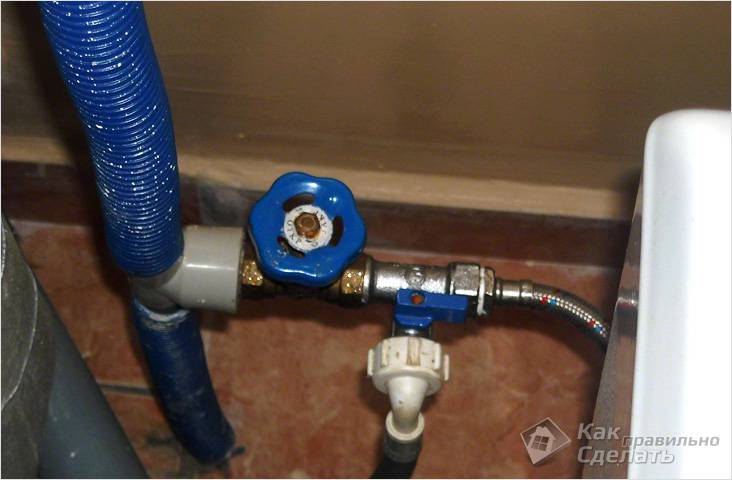
You should know how to properly connect the washing machine to the water supply. Water feeding is a responsible event. For this, the manufacturer has provided a special flexible hose, as well as special fittings. In some cases, the length of the hose may simply not be enough. What to do in such a situation? There are two solutions:
- Purchase a longer rubber hose.
- Carry out a stationary installation.
In the first case, the task is quite simple. You just need to connect the product through a hose from the intake point to the outlet on the washing machine. Make sure there is a rubber seal on both sides of the hose. Otherwise, water leakage will occur.
 Bay organization option
Bay organization option
When connecting the hose, three important requirements must be fulfilled: firstly, it is unacceptable to lay the hose in a place where there is a risk of mechanical damage. The hose can be brought in, for example, under a bathtub; secondly, the hose tension is not allowed. During the operation of the unit, deformation may occur due to vibration of the machine; thirdly, the pipeline must provide an airtight and reliable connection.
If you follow these simple rules, then further operation will not cause any problems.
As for the second option for connecting the machine - stationary, then you will have to work harder here. To implement this plan, you will need to use metal or polypropylene pipes. But it should be noted right away that as a result of the use of steel pipes for this purpose, clogging of important units may occur due to rust particles. It is better to opt for plastic pipes.
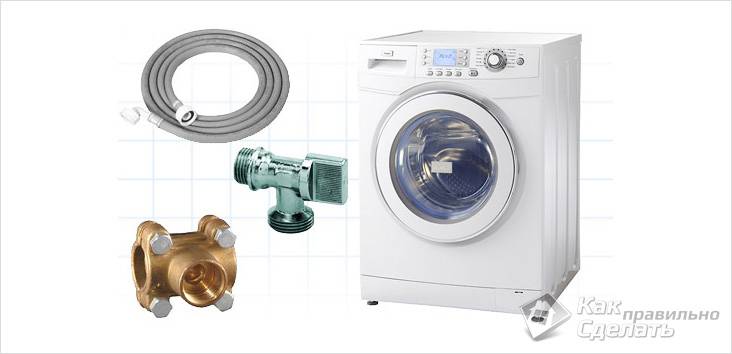 Elements required for connection
Elements required for connection
So, no matter which option you choose to connect to the water supply, a number of conditions must be met:
- The connection must be made using a ball valve. This is necessary so that the water supply can be interrupted.
- Before entering the washing machine, it is worth installing a small coarse filter. This will protect against clogging problems in internal components.
- The water connection is carried out using ready-made bends or using a tee from the main pipeline.
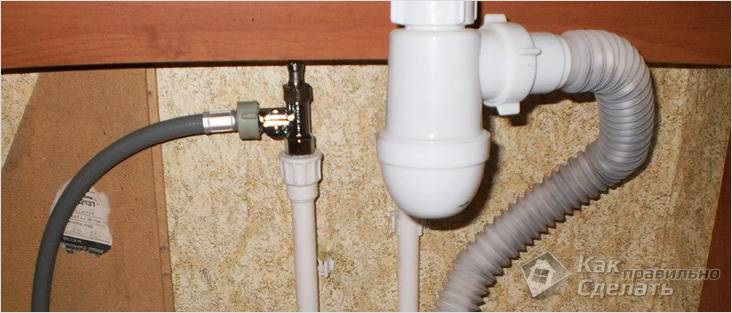 Tapping into the water supply using a tee
Tapping into the water supply using a tee
Stage 7. Test activation
After completing all installation work, you need to check the correct connection of the device by making a test run. In this case, it is not necessary to load things into the drum, but to carry out "sea trials" without a load.

During a test run, you need to pay special attention to the following nuances:
- The rate of water collection in the tank. If it is too long, then the pressure in the supply hose may be insufficient.
- There should be no leaks at the joints of hoses, pipes, fittings. If any are found, you need to tighten the nuts tighter, or it is better to seal the joints with winding and seals.
- The circulation of water during washing, rinsing and spinning should take place without problems and delays.
- During the operation of the equipment, various extraneous sounds should not be heard. Vibrations, mechanical knocks may indicate the unevenness of the base on which the machine is installed, or that all transport fixing elements have not been dismantled.
If any problems are found during the test run, they should be resolved promptly.
Water connection
First, about what kind of water the washing machine is connected to. Generally - to the cold. The water is then heated by heating elements as required. Some owners connect to hot water in order to save money. This way, washing less energy is consumed. But the savings are doubtful - more hot water goes away. If a meter is installed on the hot water supply, it is cheaper to pay for electricity than for hot water. It is also worth considering that connecting the washing machine to hot water is not very good in relation to linen: proteins curl up from temperature and then do not wash well.
This was about ordinary washing machines, but there are models that are connected to both hot water and cold water. They have not one water inlet on the back wall, but two. They are very rare in our country - there is too little demand, and the prices for such equipment are much higher.

There are washing machines that connect to both hot and cold water
Now about the connection itself. The washing machine comes with a rubber hose, which you need to connect the washing machine to water. Its length is 70-80 cm, which is not always enough. If necessary, in shops selling plumbing, you can buy a longer one (3 meters is not the limit, it seems).
This hose is screwed onto the corresponding outlet on the rear wall. There should be a rubber gasket there, so there is no need to rewind. Tighten the union nut of the hose (plastic) by hand, if you use wrenches, then just tighten it by half a turn. Not more.

Screw the inlet hose to the special outlet on the rear wall of the housing
The other end of the hose must be connected to the plumbing system. If you have a free outlet somewhere that ends with a tap - great, if not, you need to make a tie-in.
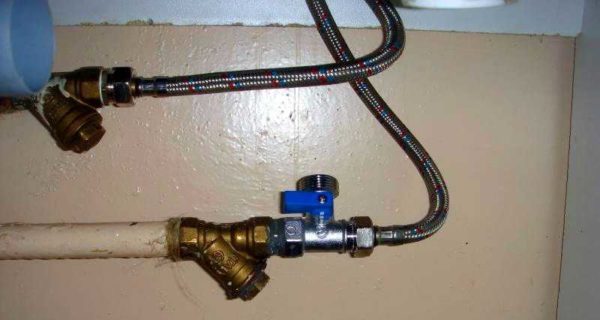
If there is a free drainage of water, it is very simple to connect the washing machine to the water supply system - put a filter, to it - a hose. Everything
The easiest way is with plastic, polypropylene or metal-plastic pipes - they bought a tee (with one transition to the metal), soldered / installed. If the water supply is divorced with a metal pipe, you will have to embed the tee by welding.
In any case, a tap is placed after the tee. Simpler and cheaper - ball. When installing it, you can wind linseed tow on the thread and grease it with paste.
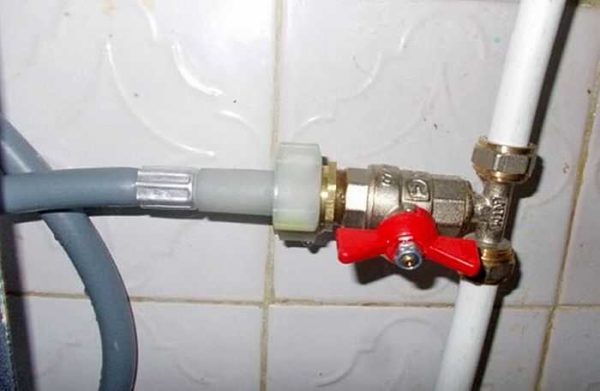
After the tee, put a ball valve, already connect the hose to it
There are also tees with taps for connecting washing machines and other household appliances. The same ball valve is installed in one of the branches, but everything is done in one body. It looks more compact, but if the crane malfunctions, you will have to change the entire tee, but it costs decently.

Taps and tees for connecting household appliances
Sometimes it is advised to put a filter before the tap.Of course, it will not be superfluous, but if there is a filter at the entrance to an apartment or house, then there is no urgent need for it.
How to install a washing machine with your own hands?
Unlike their predecessors - machines, in which water was poured and drained manually, the machines are connected not only to the mains. You also need to know how to connect the washing machine to the water supply and sewerage system. Let's consider each stage in detail.
Inspection
Most often, shops independently deliver the sold washing machines to their homes - this technique is cumbersome, special, so the seller, by providing such a service, makes life easier for his customers. Before accepting the goods and signing the receipt documents, open the packaging. Or even suggest that the delivery providers do it themselves. Inspection procedure:
- Examine the machine carefully - there should be no dents or scratches on the body.
- Shake the machine lightly from side to side - there should be no knocks or sounds.
During transportation, the device could be damaged - but you should not put up with this, demand to replace the damaged model.

External damage spoils not only the external appearance - during the impact, internal parts could be damaged. Moreover, this may not appear immediately, but over time. You will have to take the device for repair under warranty - why do you need extra problems?
Such situations rarely happen - usually cars are delivered intact. If the condition is normal, sign and send delivery workers. If you decide to do the installation yourself, start preparing.
Removing transport parts
For safe transportation, special fasteners are attached to the washing machine. These are usually all sorts of bars, bolts and brackets - they are needed to fix the tank. They must be removed. If the tank vibrates during transport, it can damage nearby elements. If the fasteners are not removed, the tank will not rotate. Imagine what happens if you plug the AGR into the network, the engine starts working, and the tank is static - a breakdown is extremely likely. To do everything correctly, read the manufacturer's instructions - installation instructions must be attached to the equipment. Also read our article on shipping bolts.
Where to put it?
Regardless of who is installing the washing machine, it is necessary to decide in advance on the place - so that the SMA fits there. Often the model is selected precisely taking into account the availability of free space.
If the area is limited, you need to take measurements and, based on them, buy the modification that will fit in the designated place: this is especially important when buying built-in appliances. Well, if there is no shortage of free space in your home, take any option - you can focus on more important criteria for you
Some appreciate the design, others - the presence of modes, roominess, etc.
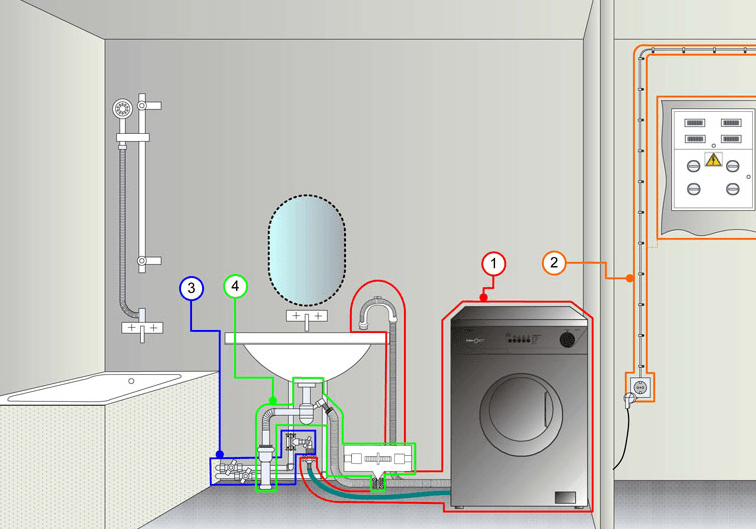
Typically, SMA is installed where there is a convenient approach to water supply and sewerage. They are placed more often in bathrooms, kitchens, lavatories, less often in corridors or closets.
Level setting
The device must stand perfectly level, the level of noise and vibration during its operation depends on it. When skewed, vibrations will increase, especially in the spin mode. To keep the equipment on a perfectly flat horizontal surface, use a building level. To put the machine straight, adjust the height of its legs. Each support is fixed at the desired height with the help of locknuts - so that they do not unwind and do not have to level them again.

What are the basics of installing a washing machine?
After you have completed all the basic preparatory work, you can proceed directly to the installation. Before putting the machine in its new place, be sure to check the level of the floor surface, it must be very even. Now you can place the car, but do not forget to use the level as well.After putting the machine in place, place a level on the top cover. The values should preferably be flat, deviations are allowed no more than two degrees.
In fact, installing a washing machine at home with your own hands is not such a complicated procedure, you just need to adhere to the main trends of the instruction.
The support feet of the washing machine are designed so that you can adjust them to create a level surface. Remember that you cannot strictly adjust any elements under the legs of the machine, since during intensive work they can fall out. The only option allowed is a thin rubber mat. It is required without fail if you notice instability and your floor surface is made of tiles.
Correct installation of the washing machine will serve as an excellent reason for a long and smooth operation.
Once you have finished installing the case, you should mechanically fix the leg support. Before connecting the washing machine to work, you should consider the following nuances:
- the device will be installed properly after you adjust the legs as much as possible;
- if you are installing the device on an inclined surface, then you need to come up with fixing elements that will help you strengthen the supporting structure;
- stability can be checked by rocking the machine from side to side. There should be no free wheeling at all.
Installing a washing machine yourself: pros and cons
Before you connect the washing machine with your own hands, you need to familiarize yourself with the advantages and disadvantages of self-installation of such a device.
The main advantages include the following:
- Saving money. If a person manages to put the machine at home and connect it to the sewer system, he will save a lot of money. He will not have to spend finances on calling a specialist and paying for his services.
- Ease of repair. It is much easier for a person who installed the machine to install the machine on his own to repair the problems that have appeared. After all, he knows how it was connected, and he will not need to spend time studying how it was connected during installation.
Among the shortcomings, there is a high probability of breakdowns, especially if a person installed a washing machine for the first time in his life. That is why many advise to trust the connection of washing machines to professionals.

